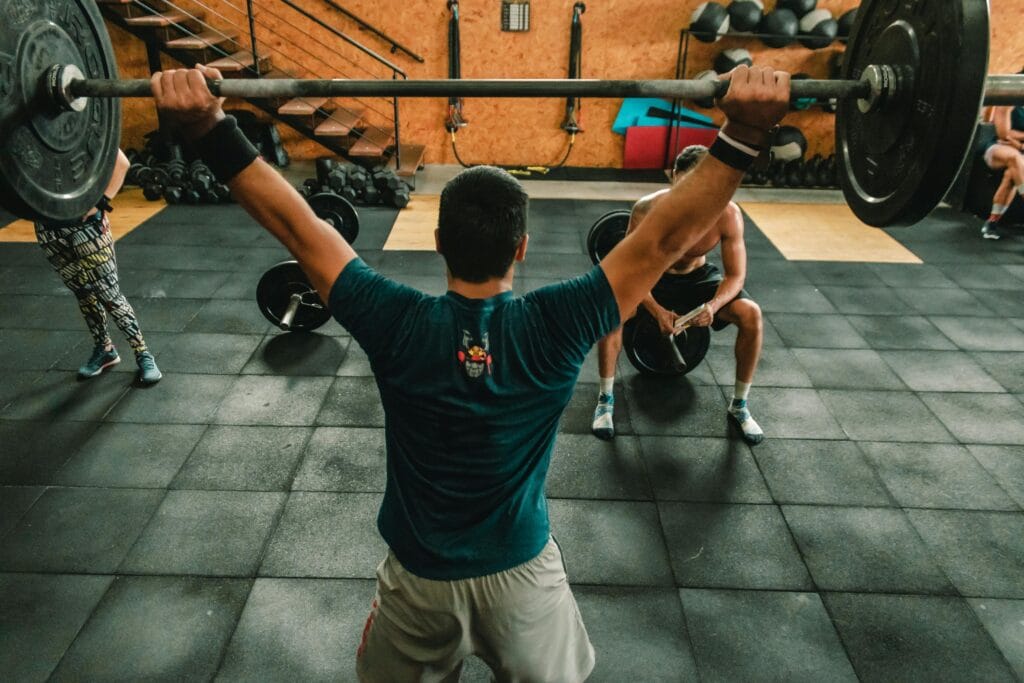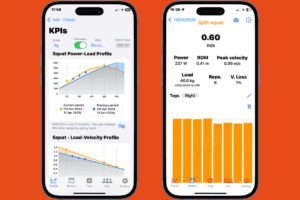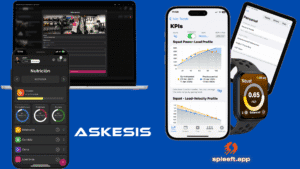Nell'allenamento delle prestazioni, comprendere la relazione tra forza, velocità e potenza è fondamentale per massimizzare il potenziale atletico. Queste relazioni sono spesso rappresentate attraverso relazione forza-velocità E curva forza tempo, così come profili come il profilo carico-velocità E profilo potenza-caricoQuesti concetti consentono agli atleti di personalizzare il loro allenamento per sviluppare attributi specifici, che si tratti di potenza esplosiva, forza massima o velocità.
Questo articolo approfondisce la scienza alla base di queste relazioni, esplorando come possono guidare piani di allenamento efficaci. Inoltre, introdurremo Spleen, un'app innovativa che fornisce misurazioni e approfondimenti in tempo reale su parametri di forza, velocità e potenza, consentendo agli atleti di adattare il proprio allenamento con precisione e chiarezza.
SCARICA ORA L'APP SPLEEFT PER iOS, ANDROID E APPLE WATCH!
Ottimizzazione delle prestazioni atletiche
Qual è la relazione forza-velocità?

IL relazione forza velocità descrive la relazione inversa tra la forza che un muscolo può produrre e la velocità alla quale si contrae. In termini più semplici, quando sollevi un carico pesante, lo sollevi lentamente (forza elevata, bassa velocità), mentre un carico leggero può essere sollevato rapidamente (forza bassa, alta velocità). Questo principio è fondamentale nell'allenamento della forza, poiché aiuta a identificare il tipo di azioni muscolari più adatte a specifici obiettivi atletici.
Per esempio:
- Forza massima: L'allenamento con carichi pesanti a bassa velocità (forza elevata) sviluppa la forza massimale, fondamentale per il powerlifting e gli sport in cui la forza bruta è fondamentale.
- Velocità: L'allenamento con carichi più leggeri ad alta velocità (bassa forza) aumenta la velocità e l'esplosività, il che è utile per sport come lo sprint o il basket.
Studiando la relazione forza-velocità consente ad atleti e allenatori di personalizzare gli esercizi mirati a parti specifiche di questo spettro, bilanciando i compromessi tra forza e velocità per un effetto di allenamento ottimizzato.
Comprensione della curva forza-tempo
IL curva forza tempo è una rappresentazione grafica della forza generata nel tempo durante un movimento, che rivela la rapidità con cui un atleta può sviluppare forza. Questa misura è fondamentale negli sport in cui la potenza esplosiva è essenziale, come il salto o lo sprint. Una curva forza-tempo più ripida indica un'elevata tasso di sviluppo della forza (RFD), ovvero la capacità di generare forza rapidamente, una caratteristica fondamentale per prestazioni sportive esplosive.
Come la curva forza-tempo influisce sull'allenamento
- Tasso di sviluppo della forza (RFD): Un RFD elevato significa che la forza può essere prodotta rapidamente. L'allenamento incentrato sulla massimizzazione dell'RFD (ad esempio, esercizi pliometrici ed esplosivi) produce movimenti più rapidi e potenti.
- Forza massima: Il picco della curva forza-tempo rappresenta la forza massima prodotta. Sviluppare la forza massima è essenziale per gli atleti concentrati su sport basati sulla forza.
Capire il curva forza tempo consente agli atleti di valutare i propri modelli di sviluppo della forza e di progettare protocolli di allenamento che massimizzino la loro capacità di produrre forza rapidamente o di sostenere forze elevate per una durata specifica.
Il profilo carico-velocità
IL profilo carico-velocità è un grafico che mostra la relazione inversa tra il carico (peso) e la velocità a cui può essere spostato. È una parte della relazione forza-velocità. Questo profilo è unico per ogni atleta ed esercizio e funge da prezioso strumento per ottimizzare i carichi di allenamento.
Come utilizzare il profilo carico-velocità nell'allenamento
- Scegli intervalli di carico ottimali: IL profilo carico-velocità aiuta a determinare l'1RM stimato o un rep max, la variabile più importante nella scelta dei carichi in qualsiasi programma di allenamento. In base a ciò, puoi scegliere quale carico vuoi mettere sulla barra (%RM)
- Identificare i punti di forza e di debolezza dell'atleta. Profilando un atleta, puoi scegliere quale parte del profilo carico-velocità allenare. Ad esempio, nell'immagine qui sotto, l'atleta dovrebbe concentrarsi su carichi elevati. La sua prestazione è superiore a quella dei suoi compagni di squadra con carichi leggeri, ma perde prestazione con carichi elevati.

IL profilo carico-velocità fornisce agli atleti un modo pratico per adattare il carico di allenamento alla loro attuale capacità fisica, massimizzando l'efficienza di ogni allenamento.
Il profilo potenza-carico
IL profilo potenza-carico illustra come carichi diversi influiscono sulla potenza in uscita, identificando il punto in cui un atleta genera la massima quantità di potenza. La potenza, definita come il prodotto di forza e velocità, è fondamentale per prestazioni esplosive in sport come calcio, basket e atletica.
Importanza del profilo potenza-carico nell'allenamento
- Trovare la potenza di picco:Identificando il carico in cui la potenza è massima, gli atleti possono personalizzare i propri allenamenti includendo esercizi che enfatizzano questo carico, sviluppando una potenza esplosiva.
- Equilibrio tra forza e velocità: IL profilo potenza-carico evidenzia il punto di equilibrio tra forza e velocità, aiutando gli atleti ad adattare la propria attenzione per aumentare la velocità o la forza a seconda dei propri obiettivi prestazionali.
- Monitoraggio dei progressi: Tracciamento delle modifiche nel profilo potenza-carico nel tempo fornisce informazioni preziose sullo sviluppo di un atleta, aiutandolo a vedere come gli aggiustamenti nell'allenamento influiscono sulla potenza erogata.
Per gli atleti che mirano a ottimizzare la potenza, comprendere il profilo potenza-carico è essenziale per progettare allenamenti che colgano il giusto equilibrio tra forza e velocità.
Utilizzo dei profili Forza-Velocità e Potenza-Carico nell'allenamento
Integrando relazione forza velocità approfondimenti, nonché dati provenienti da profilo di velocità del carico E profilo di carico di potenza, gli atleti possono sviluppare strategie di allenamento che enfatizzano le loro specifiche esigenze di prestazione. Ecco come applicare questi principi:
- Sviluppare un programma equilibrato: Utilizzare il relazione forza velocità per creare un programma di allenamento bilanciato che alterna sessioni ad alta velocità e ad alta forza. Questo approccio aiuta gli atleti a sviluppare sia la velocità che la forza senza sovraccaricare l'una a scapito dell'altra.
- Enfatizzare lo sviluppo del potere: IL profilo potenza-carico aiuta a individuare i carichi che massimizzano la potenza. Includere esercizi con questi carichi, come i salti con peso, consente agli atleti di allenarsi al massimo della loro potenza.
- Regola l'intensità in base al feedback: Con app come Spleengli atleti possono monitorare la velocità in tempo reale, il che li aiuta a decidere quando aumentare l'intensità e quando concentrarsi sul recupero.
Per un allenamento ottimale è fondamentale combinare elementi dell' relazione forza velocità, curva forza tempo, profilo carico-velocità, E profilo potenza-carico in un programma coerente che si allinea con gli obiettivi dell'atleta.
Forza di tracciamento, velocità e potenza con Spleeft
Per gli atleti che desiderano monitorare con precisione i propri relazione forza velocità e altre metriche di performance, Spleen fornisce una soluzione avanzata. Questa app cattura dati su carico, velocità e potenza in tempo reale, offrendo agli atleti un feedback immediato per perfezionare i loro allenamenti.
Principali vantaggi dell'utilizzo di Spleeft per il monitoraggio
- Monitoraggio della velocità in tempo reale: Spleeft consente agli atleti di misurare la velocità per ogni sollevamento, aiutandoli a capire come la loro velocità si allinea con il loro obiettivo profilo carico-velocità.
- Analisi automatica potenza-carico: L'app calcola il profilo potenza-carico in base alle tue prestazioni, individuando il carico che massimizza la potenza in uscita.
- Monitoraggio della curva del tempo della forza visiva: Le analisi di Spleeft includono il curva forza tempo, fornendo approfondimenti sui modelli di sviluppo della forza che sono essenziali per prestazioni sportive esplosive.
- Feedback personalizzato per un allenamento ottimizzato:Con Spleeft, gli atleti possono vedere all'istante la propria prestazione in termini di forza, velocità e potenza, il che consente loro di adattare il proprio allenamento in base ai dati in tempo reale.
Utilizzando Spleen semplifica le complessità di relazione forza velocità e altre metriche, fornendo agli atleti informazioni pratiche che migliorano le loro prestazioni.
Migliorare le prestazioni con la formazione basata sui dati
Capire il relazione forza velocità, curva forza tempo, profilo carico-velocità, E profilo potenza-carico è essenziale per gli atleti che mirano ad allenarsi con precisione. Incorporando questi principi, gli atleti possono ottimizzare i loro programmi di allenamento per soddisfare le loro esigenze specifiche, che si tratti di sviluppare potenza esplosiva, aumentare la velocità o massimizzare la forza.
Con monitoraggio in tempo reale da app come Spleen, gli atleti hanno accesso a metriche essenziali che aiutano a personalizzare gli allenamenti, prevenire il sovrallenamento e monitorare i progressi. Abbraccia l'allenamento basato sui dati con Spleen per sfruttare appieno la scienza della forza, della velocità e della potenza per ottenere le massime prestazioni.





